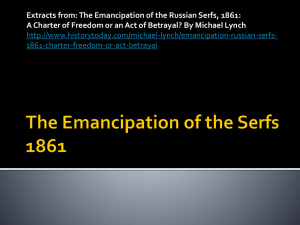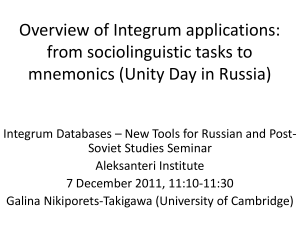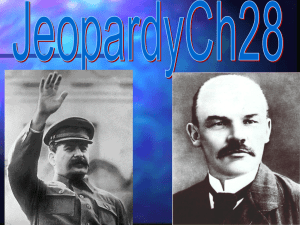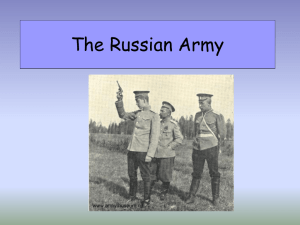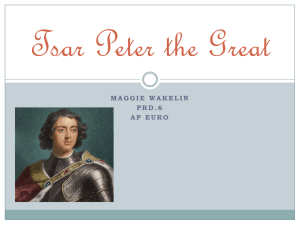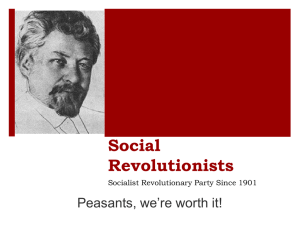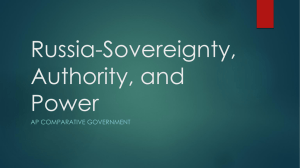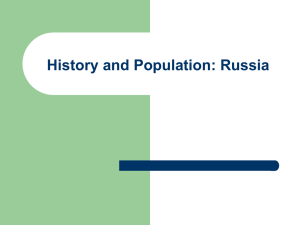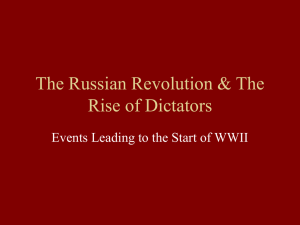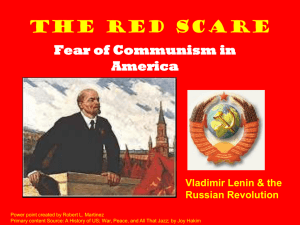Twentieth Century Russian History
advertisement
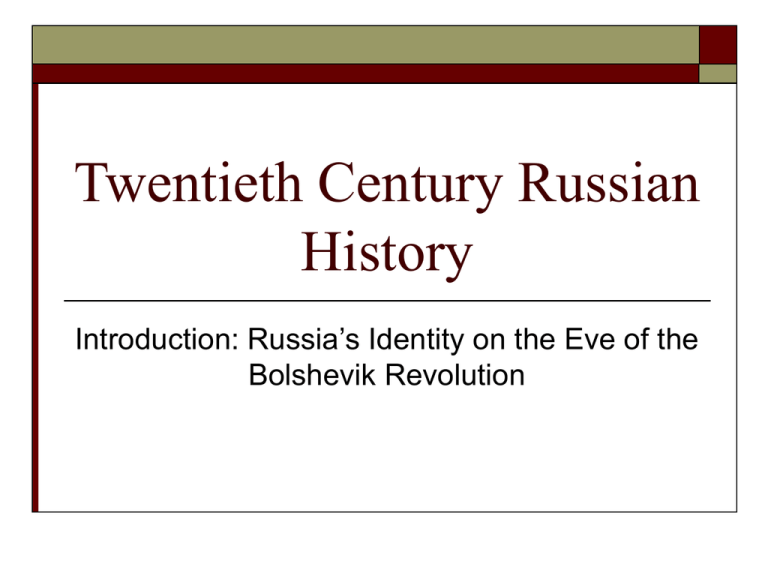
Twentieth Century Russian History Introduction: Russia’s Identity on the Eve of the Bolshevik Revolution Objective #1: Peter the Great’s Impact on Russian Identity Peter the Great Cutting off Beards Objective #1: Peter the Great’s Impact on Russian Identity Peter the Great (1672-1725) (ruled 1682-1725) • Completely transformed Russia with his reforms “from above.” Made Russia a European power for the first time in its history. • Used successful Western European countries as an example for his political, social and military reforms: - Holland, Sweden, England, Prussia • Forced major changes upon an unwilling Russian population. Used brutal means to achieve Russia’s modernization. • His reforms began the widening gulf between a “westernized” Russian elite (nobles & civil servants) and the traditional, highly religious Russian peasants who preserved the old customs, traditions and language. Objective #1: Peter the Great’s Impact on Russian Identity • From Peter’s reforms emerged two intellectual tendencies that exist to this day: 1. Slavophiles - emphasized the uniqueness of Russia’s (Slavic people’s) traditions, norms, ideas. - Uniqueness of Russian country life – the mirs. Rejection of competition and individualism. - the uniqueness and special place of the Russian Orthodox Church in the lives of the people - opposed Western influence in Russia as alien / opposed Peter the Great and his reforms as ruinous to Russia’s “organic” development - opposed limitations on the Czar’s power / opposed people’s participation in politics - advocated a foreign policy that would support other Slavic people (especially Orthodox) in their quest for liberation from the Austrian and Ottoman Empires Objective #1: Peter the Great’s Impact on Russian Identity • Rejected all of the major political, cultural, religious, economic ideas coming from Western Europe: - Renaissance, The Protestant Reformation, the Enlightenment, The Industrial Revolution A. Khomiakov I. Aksakov K. Aksakov I. Kireevsky Y. Samarin Objective #1: Peter the Great’s Impact on Russian Identity 2. Westernizers • Believed that Russia’s development depended on the adaptation of Western technology and culture, liberal government, capitalist economy. • Some Westernizers believed Russia should convert to Catholicism. Many were critical of the Russian Orthodox Church as the source of backwardness and superstition in the country. • Viewed the westernizing reforms of Peter the Great as the beginning of Russian history. Before that, Russia accomplished nothing. Peter Chadaaev Alexander Herzen Vissarion Belinsky Objective #2: The Orthodox Church and Russian Identity Objective #2: The Orthodox Church and Russian Identity • Russia became a Christian nation in 988. Kievan Prince Vladimir chose the Eastern (Byzantine) Christian Church. - Vladimir was first approached by Muslim Volga Bulgar representatives who tried to persuade him to convert to Islam. He rejected the Muslims on the grounds of their prohibition against eating pork, drinking alcohol and mandatory circumcision. - Next, an emissary from Rome came to Vladimir but he considered western Christianity “strange” and inadequate compared to the Orthodox faith. - Vladimir rejected conversion to Judaism because the Jews were a people without a nation who lost the support of God. - Vladimir listened to a Greek Orthodox monk explain how the Catholics went astray and why the Jews were “punished by God for their sins.” He was impressed. He sent representatives to Constantinople to witness an Orthodox service. They were awe struck.. Objective #2: The Orthodox Church and Russian Identity • The conversion to Eastern Orthodox Christianity brought a new alphabet – Cyrillic. - Cyrillic – the alphabet of the Orthodox Slavic people devised by Saints Cyril and Methodius in the 7th century AD. • When the Eastern and Western Christian churches split in 1054, Russia went East. • The cultural / religious influence was from Constantinople, not Rome. Objective #2: The Orthodox Church and Russian Identity • According to Nikolai Berdyaev, Russians have gained the following qualities from Orthodoxy: - dogmatism - asceticism - the ability to endure suffering and to make sacrifices for the sake of faith whatever it may be - a tendency towards apocalyptic and nihilistic behavior Objective #2: The Orthodox Church and Russian Identity “Moscow as the Third Rome” • Theory developed between 1523-1526 by Russian Orthodox Monk Filofei. • As a result of the fall of Constantinople and the Byzantine Empire at the hands of the Muslim Ottoman Empire (1459), Moscow must now become the center of the true Christian faith. It was up to Russia to save Christianity and all Christians. • Rome was the first Christian center / Constantinople was the center of Orthodox Christianity until 1459. • An example of Russian “messianism.” Russia’s mission to save Christianity. This messianic spirit will present itself in 1917 in the form of building communism. Objective #2: The Orthodox Church and Russian Identity • According to Berdyaev, the best period of the Russian Orthodox Church was during the Tartar / Mongol occupation: - it was spiritually the most independent - led the liberation from Mongol domination - Orthodox faith came increasingly to be seen by Russians as “Russia faith.” Greek was no longer seen as pure. Orthodoxy became a Russian national idea. Objective #2: The Orthodox Church and Russian Identity • Russian messianic consciousness – the search for a kingdom based on justice. • Russian messianism resembled Jewish messianism: - Russian and Jewish identity intimately linked to religious faith - Both set out to save civilization - According to Berdyaev, this is why communism took hold in Russia. A large proportion of Bolsheviks were Jews and the majority were Russian. Objective 3: Geography and Russian Identity Objective 3: Geography and Russian Identity Objective 3: Geography and Russian Identity • “Half of Russia is Europe; half of Russia is in Europe.” – Vladimir Baranovsky • The Ural Mountains separate European from Asian Russia. • Located at the crossroads of Europe and Asia / West and East / Christian and Muslim civilization / Christian and Buddhist civilizations • Russia was occupied by the Mongols from the East for 240 years (12401480). • A significant direction of Russian expansion was eastward – Siberia, Central Asia, Far East. • Russia’s Caucasian population descends from Turkic tribes from Central Asia. Russia contains over 100 various ethnic groups. • Objective 3: Geography and Russian Identity • Berdyaev: One of Russia’s major problems is how to organize its vast territory. - “The immensity of Russia, the absence of boundaries, was expressed in the structure of the Russian soul.” - “The landscape of the Russian soul corresponds with the landscape of Russia, the same boundlessness, formlessness, reaching out into infinity, breath.” • Russia’s geography: A major factor contributing to traditional Russian authoritarianism - “The state expands, the people grow sickly.” Vasily Klyuchevsky Russia’s Identity: Vladimir Baranovsky According to Vladimir Baranovsky, three identities for Russia: 1. Russia is Europe - part of a larger Christian civilization - Russia and Europe belong to the same family a. Russia is imperfect Europe - underdeveloped / backward / failing European state b. Russia is the best Europe - Russian art, literature the best examples of European culture c. Russia is another Europe - representative of its eastern variant (through the Byzantine Empire) Russia’s Identity: Vladimir Baranovsky 2. Russia is Asian - In opposition to the West - The source of Christianity in Russia, the Byzantine Empire, was a deviation from Europe and increasingly Asian - Russia was under Mongol occupation for over 200 years (1240-1480) > Alexander Nevsky, the great Russian hero, fought against Catholic Sweden and the Teutonic Knights but did not do so against the Mongols > The Renaissance did not reach Russia > Increasingly, Russian economic relations expanded greatly into Central Asia, Afghanistan, Persia > Russia’s greatest expansion was into Asia: Siberia, Central Asia and the Far East Russia’s Identity: Vladimir Baranovsky 3. Russia is unique / a world in itself - The Orthodox religion stands opposed to both Western Christianity and Islam - Russia is not based on one ethnicity / composed of over 100 – “Rossiyane” - Extremely culturally diverse Russian Identity: Eurasianism Eurasianism – conceived in the 1920’s - believe in the collectivist nature of Russian life - Western-style democracy to traditional Russian political culture - Criticized the West for not having a “grand goal” and for lacking a sense of “spiritual messianism” - The West was overly materialistic and morally bankrupt - Russia was more Asian than Slavic: “Turkic blood mingles in Russian veins.” N. Trubetskoi - Contrary to Russian nationalists who feel that Russians should be the dominant ethnic group in Russia, Eurasianists feel that Russians are but one of many different ethnic groups that should share leadership - The Eurasian landmass should be unified politically, culturally, and economically Russian Eurasianists: Then and Now Nikolai Trubetskoi Lev Gumilev Alexander Dugin
